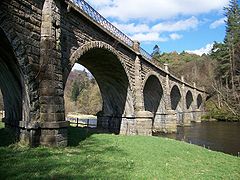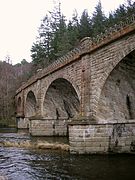Neidpath Viaduct: Difference between revisions
No edit summary |
|||
| Line 53: | Line 53: | ||
==References== | ==References== | ||
{{reflist|colwidth=30em}} | {{reflist|colwidth=30em}} | ||
{{Tweed bridges}} | |||
Latest revision as of 21:24, 15 August 2020
| Neidpath Viaduct | |
| Peeblesshire | |
|---|---|
 Neidpath skew viaduct | |
| Location | |
| Carrying: | Footpath |
| Crossing: | River Tweed |
| Location | |
| Grid reference: | NT232401 |
| Location: | 55°38’57"N, 3°13’15"W |
| Structure | |
| Main span: | Eight equal spans of 32' 6" |
| Design: | Skew viaduct |
| Material: | Sandstone |
| History | |
| Information | |
Neidpath Viaduct, also known as the Queen's Bridge,[1] consists of eight stone skew arches and was built to carry the Symington to Peebles branch line of the Caledonian Railway over the River Tweed to the south-west of Neidpath Castle.
The viaduct is now closed to rail traffic and the bridge is used as a footpath.
History
The Symington, Biggar and Broughton Railway's extension to Peebles was authorised on 3 July 1860 but by the time construction was complete the company had been absorbed by the much larger Caledonian Railway.[2]
The bridge was designed by Robert Murray, a local architect living in Peebles, and George Cunningham, Consultant Engineer to the Caledonian Railway, and built of sandstone ashlar blocks. All eight arches are semicircular, skewed and constructed with helical courses, crossing the Tweed obliquely with four of the piers in the water, and the whole structure is built on a graceful curve of radius 440 yards so as to align the route with nearby Neidpath Tunnel, at the eastern end of the viaduct and to the south of Neidpath Castle.[2]
The similar but smaller Lyne Viaduct is located a little to the west and is often confused with this bridge.[3]
On 1 January 1923 ownership of the viaduct, along with the rest of the Caledonian Railway, passed to the London, Midland and Scottish Railway and thence to the Scottish region of British Railways on nationalisation in 1948. The line lost its regular passenger traffic on 5 June 1950 and closed completely on 7 June 1954. It is now listed as a Category A listed structure, as it is one of the finest examples of skew arch construction in Britain. The old railway line has been converted into a footpath, which therefore crosses the river on the viaduct.[1] The viaduct remains open to walkers and its picturesque setting is popular with ramblers.
Pictures
Outside links
| ("Wikimedia Commons" has material about Neidpath Viaduct) |
References
| Bridges and crossings on the River Tweed | ||||||
|---|---|---|---|---|---|---|
| Stobo Bridge | Lyne Footbridge | Manor Bridge | Neidpath Viaduct | Fotheringham Footbridge | Tweed Bridge | Priorsford Footbridge |




